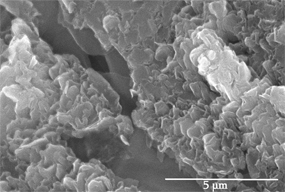Article contents
High-capacity potato peel-shaped graphite for lithium-ion batteries
Published online by Cambridge University Press: 05 September 2011
Abstract

Highly graphitic carbons are obtained by precipitating carbon from molten steel inoculated with bismuth. Scanning electron microscopy images show that the products have a potato peel morphology. The inoculant leads to a breaking of the local symmetry of the graphitic structure as evidenced by Raman spectroscopic studies. The products exhibit flat charge–discharge profiles below about 200 mV versus Li+/Li, reversible capacities even exceeding the theoretical limit of 372 mAh/g for perfectly graphitic structures, low first-cycle irreversible capacities, and sustained hundreds of cycles.
- Type
- Rapid Communications
- Information
- Copyright
- Copyright © Materials Research Society 2011
References
- 4
- Cited by


